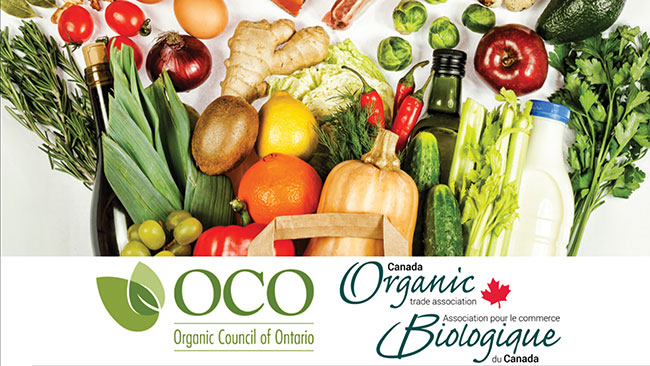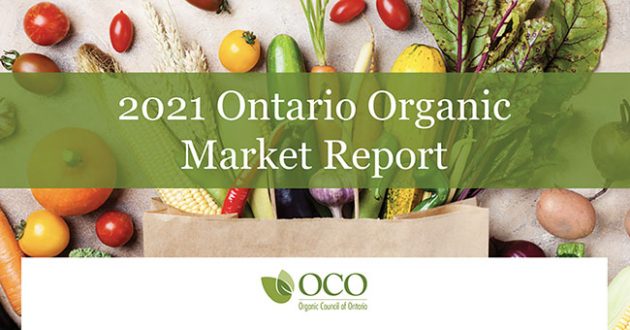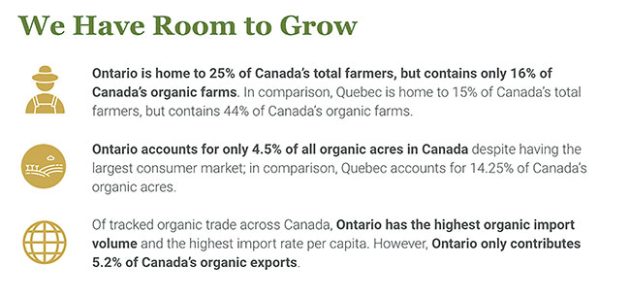
Features
Markets
Organic Perspective
Examining the Organic Market Report
Ontario market for organic products is the largest in Canada, with demand increasing.
May 10, 2022 By Samantha Mills, OCO
 Ontario has the highest proportion of organic shoppers in Canada, with 71 per cent of Ontarian survey respondents saying they have purchased organic products. Graphics courtesy of the Organic Council of Ontario.
Ontario has the highest proportion of organic shoppers in Canada, with 71 per cent of Ontarian survey respondents saying they have purchased organic products. Graphics courtesy of the Organic Council of Ontario. With the support of the Canada Organic Trade Association (COTA), the Organic Council of Ontario (OCO) has recently published their 2021 Ontario Organic Market Report. Using in-depth data from leading market researchers, the report catalogues the strength of Ontario’s demand for organic products and tracks the growth of the organic sector and opportunities for new producers. The report is a key resource for producers seeking to better understand how the organic market is growing and to identify underserved markets. The following summary explores some of the insights found within the full report, which can be found on the OCO website at organiccouncil.ca.
Sector growth
Nationwide data shows the demographic of organic food buyers is continuing to broaden. In 2020, we saw an increase in organic purchases across every demographic and income level, demonstrating that organic products are shifting away from a luxury good solely for parents or the wealthy and more towards an element of everyday life. While the reason for this increased interest likely varies, it is suspected that the COVID pandemic triggered a rise in consumers prioritizing their health, the environment and their local food system.

Although Ontario’s organic industry grew in 2020, in most industry sectors this growth has yet to fully recover the ground lost from a dip in 2019. Comparatively, Quebec holds the largest presence in the organic industry among the other provinces. The only area in which Ontario outpaces Quebec is organic livestock operators, a sector that has always had a high demand in Ontario. The continuous growth of Quebec’s organic industry is due, at least in part, to the provincial government’s commitment to organic agriculture. Since 2015, Quebec’s government has developed a robust suite of supports including grants, subsidies and learning programs. This trend suggests that Ontario’s organic industry could flourish in the same way with similar support.
OCO has long advocated for these kinds of government programs because these supports are critical to organic farmers, especially during their initial years in transition. COTA recently launched the Support Organic Change Fund, which is a privately funded national program designed to help conventional farmers transition to organic or to help organic farmers expand their operations. The fund will cover up to 64.18 per cent of certification costs.

Although Ontario’s organic industry grew in 2020, in most industry sectors this growth has yet to fully recover the ground lost from a dip in 2019. Graphics courtesy of the Organic Council of Ontario.
Who is the organic buyer?
Ontario has the highest proportion of organic shoppers in Canada, with 71 per cent of Ontarian survey respondents saying they have purchased organic products. Twenty-two per cent of Ontarian respondents also identified as heavy buyers of organic products (25 to 100 per cent of their groceries were organic products).
Ontario’s organic products are purchased mainly from grocery stores (81 per cent of respondents), online retailers (25 per cent) or directly from farmers (23 per cent). Top reported motivators for buying organic were to avoid processed and artificial ingredients (60 per cent), avoid pesticides or other chemicals (56 per cent) and support environmental health (42 per cent). The main obstacles were high costs (77 per cent) and the claim that locally grown food was as good or better (27 per cent).
“The [report’s] biggest take-home for me is that Quebec is out-growing Ontario in organic production, but is nowhere close to Ontario consumption-wise,” says Carolyn Young, executive director of OCO. “This indicates that Ontario is likely one of Quebec’s biggest customers.”
Imports and exports represent an opportunity
Despite Ontario’s large consumer market, the majority of organic products are imported while exports of organic products sit at 5.2 per cent. The main organic imports are spinach, strawberries and lettuce, despite the fact that these products can all be grown in Ontario. This demonstrates an opportunity to grow the province’s organic production sector – to better serve our domestic market and contribute to Canadian exports.
If you’d like to gain access to additional valuable insights and data on Ontario’s organic industry within Ontario, you can purchase the Ontario Organic Market Report on the OCO website.
About OCO
The Organic Council of Ontario (OCO) is the voice for organics in Ontario. We are the only full value chain association operating at the provincial level. OCO represents more than 1,300 certified organic operators, as well as the businesses, organizations, and individuals that bring food from farm to plate. OCO works to catalyze sector growth, support research, improve training, increase data collection, encourage market development, protect the integrity of organic claims, and inform the public of the benefits and requirements of organic agriculture.
Print this page